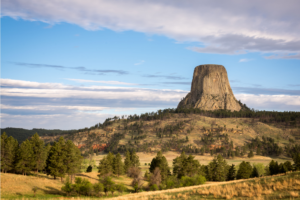In the heart of the North America, a mystery rises from earth to sky in awe-inspiring wonder. Devils Tower bursts from out of the landscape and sticks out like a sore thumb. The giant shaft of rock in North-East Wyoming breaches 386 metres (1,267 foot) above the adjacent Belle Fourche River and reaches a total of 265m (867ft) from base to summit.
This intrusive rock holds much mystery, and although there are a few theories on its origin, no one truly knows exactly when and how it was formed. With such a sinister name you would think this rock may be considered hell on earth, rising from the depths of the underworld. Instead, this name was purely a case of being lost in translation. In 1875, during America’s aggressive westward expansion, a US Army Colonel by the name of Richard Irving Dodge had led a scientific survey party on an expedition to the natural wonder and his translator mistook the native name of the geological monolith for “Bad God’s Tower”. Despite this basic error, the name remained, and Devils Tower was named the first official US National Monument by the decree of President Theodore Roosevelt on 24th September 1906 under the Antiquities Act.
However, amongst the Indigenous people of the region, its name is associated with bears, not the Devil. Variations of the name include: ‘Bear’s House’, ‘Bear’s Lodge’, ‘Bear’s Tipi’, ‘Home of the Bear’, and ‘Bear’s Lair’. All of these names are natural extensions of the Indigenous creations stories that explain the formation of the butte: there are many variations of the story but in Kiowa and Lakota oral history, the general tale tells of a young group of girls who were being chased across the prairie by a bear, so climbed upon a small rock to escape the wild beast’s pursuit. They kneeled in prayer in hope that they would be spared from the sharp claws; the Great Spirit heard their desperate prayers and made the formation rise out from the earth. As the bear attempted to reach the young girls, it scratched the rock and left the vertical lines that remain as a feature to this day. Some local names are more literal than mythological and allude mainly to the long, protruding shape of the unique monolith.
Asides from bearing bear-related names, Devils Tower is also known by the Lakota as ‘Brown Buffalo Horn, and the Kiowa call it ‘Aloft on a Rock’ or ‘Tree Rock’. The latter name alludes to the fact that Devils Tower resembles a large tree trunk from a distance. Despite firm scientific evidence, conspiracy theorists believe that the formation is a remnant from an age when giant trees littered the landscape of the earth. Some even suggest that a large amalgamation of roots lay beneath the ground below the rock, but there is no actual proof of this. The truth is that Devils Tower is formed of volcanic rock that cooled and formed into hexagonal columns that can be seen on its surface. Further erosion from rain and snow has worn away at the Tower for over 40 million years and has created the giant butte that can be seen today.
There are many other examples of similar rock formations across the globe. Buttes and monoliths in various continents can be seen in Africa (Tamanrasset Province, Algeria), Eurasia (Qaxac Qaslasi, Azerbaijan) and Australasia (Uluru, Australia).
One thing that connects all these sites is that they inspire true wonder. Such a vast object standing alone in the wilderness would make anyone question the nature of the world that we live in, and stories surrounding these buttes remain enshrined in folklore and history. The UFO film Close Encounters of the Third Kind by Steven Spielberg relies on the location of Devils Tower throughout the story. This blockbuster cinematic depiction truly shows the lasting legacy of the mystery surrounding Devils Tower. Whether it’s bears, giant trees or UFOs, the wonderful Devils Tower will continue to stand tall and rouse fascination in the minds of many.
– By James Lapping









